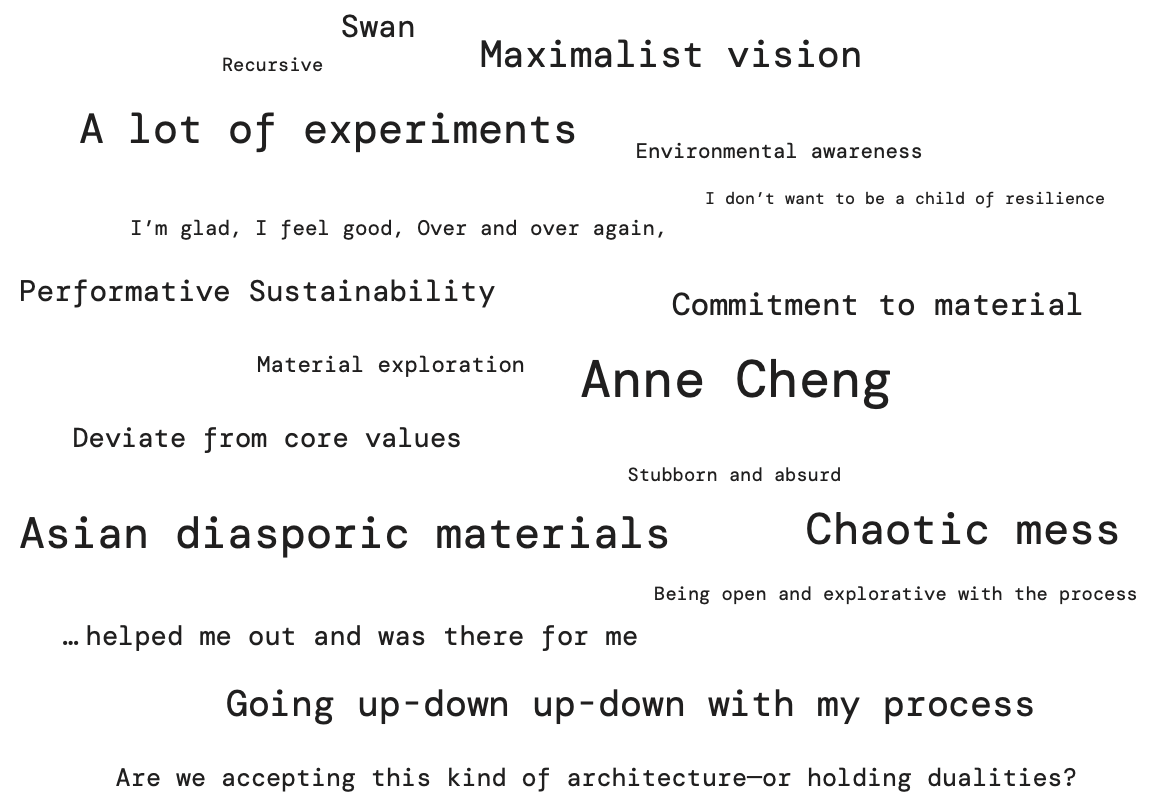Capturing RISD’s 2024 Graduate Show, a Punctuated Endeavor
Chhavi Jain
→MA GAC 2023
The way I see it, there is no singular Grad Show; there are many. Each spectator’s impression snowballs into an experiential explosion following the colossal effort of breathing life into Exhibition Halls B and C at the Rhode Island Convention Center each Spring. Similar to a blank canvas, first, the halls are spatially marked and mapped. This work, typically unseen, is executed by Director of Campus Exhibitions, Mark Moscone, and his team: Sarah Meftah (new this Fall), Gunnar Norquist, and the Senior Academic Technologist, Hasan Askari.
“By early spring, when students have a decent handle on their thesis work, individual studio visits commence over an eight-week period,” Mark tells me during a conversation, unpacking the trajectory of the multi-stage planning process. This starts a summer in advance with some preliminary ideas. “Sometimes it takes one [meeting], sometimes more,” he says, “and that’s how the show manifests.” Each year, the show is a visual spectacle. It represents nineteen Master’s programs—Graphic Design, Illustration, Global Arts and Cultures (GAC), Teaching Learning Art & Design, Industrial Design, Interior Architecture, Architecture, Photography, Landscape Architecture, Sculpture, Painting, Furniture Design, Digital+Media, Ceramics, Design Engineering, Glass, Jewelry+Metalsmithing, Printmaking, and Textiles.
This year, more than 120 images of works in the show have found a permanent home in my phone’s gallery, exhaustively captured over four days. While my memories of some of the installations are more vivid than others, a common thread—the rigor behind generating each of these theses, a culmination of work beyond the one to two years of reading, thinking, and making—has stayed with me. The Grad Show is as ephemeral as it is a reflection of years of hard work. Yet, this temporality is only deepened by the experience generated in the space, as a product of both camaraderie and finality. It thus had to be experienced, remembered, and documented as a container for knowledge, process, and labor.
The 2024 show opened with a two-hour-long reception—a rendezvous of writers, curators, local artists, and of course faculty, friends, family, staff, and alumni. Smiles, conversations, chatter, congratulatory remarks, flowers, pictures, laughter, a brief sigh, and exclamations permeated the air. Although I, too, was presenting my thesis work in the GAC cohort, I was able to appreciate the show from the perspective of a spectator as well, as I had already graduated in December 2023.
Familiar with the scale of the show, I knew better than to attempt to take it all in at one go. Like the planning, the experience of the exhibition needs to be curated. And this year, that opportunity knocked on my door. When I was invited to reflect on the show for v.1, I decided to walk through the exhibit and divide it into smaller segments. What followed was a week-long itinerary of revisiting the space, inadvertently punctuated by friends and acquaintances bringing me back to my own exhibit corner.
Floating with the Crit Cloud
In the days following the opening reception, most of the graduate departments had their final crits in the space, imbuing the exhibition hall with a sense of bittersweet culmination. Once inside the space, my attention was repeatedly diverted as I saw a friend presenting here, another work I wanted to know more about there, and multiple groups moving from work to work together. To keep up, I had to float with the crit clouds, picking up words, phrases, ideas, and the occasional photograph. This is what I came across:
During Emilia Karolina Miekisz’s (MFA IL 2024) critique.
The Exhibit in Select Photographs:
The exhibition halls have long transformed into something else, many times over by now. The 2024 Grad Show lives on in our collective memory, and there are other ways we can relive them—the Grad Show Anthology edited by Jennifer Liese, Anne West, and Kobe Jackson; the Grad Show website; various Instagram accounts; and the pictures in our phone’s galleries. The photos in my phone remind me of a time when I was wearing the proverbial security blanket of studenthood, which is now long gone. I look at these images and reflect on what was, what’s to come, and the tunnel in between that carries us through.
Chhavi Jain wants to see more people engaging with writing as art!